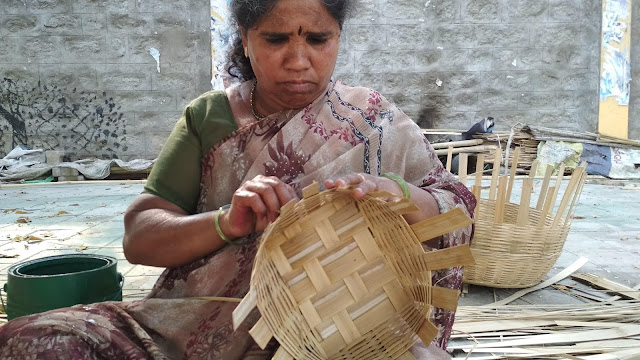Facilitating 'Action for it's own sake'
The purpose of the session was to invite children to join me in an observation of the self in action. The facilitation of this session happened in three parts.
Design/ practice of facilitation
Part I
Part II
The second part was a ‘Reflective dialogue’ for the whole group. The children were invited to share at least one thing that each of them had stayed with them or that they had found interesting from the previous day’s visit. The children shared a variety of things including their interest in the process, what they would like to try out, the sad facts about the economic/ social situation that surrounds the work. One child even said ‘I preferred the mechanical machine to the electric one because if machines do everything then what will people do?’. I share with the group that the one thing that had stayed with me was the attention with which the artisans were working - they appeared unable to take their eyes of the wood in front of them.
I raised the question ‘Have you noticed yourself work with that kind of attention?’ Some of the children shared examples of themselves in carpentry, pottery, while playing sport, etc. I used this opportunity to show the baskets I had been working on over the past few months and described to them the manner in which the experience of making affects me - how sometimes I observe that the mind is quiet and there is complete attention given to the material and the actions. However, at other times I observe that the mind is wandering from this thought to that and my mind is performing the action all on it’s own. I then read out the following piece to them:
Have you ever woven a basket? Getting started is the toughest part - making the first two sticks stay together the way you need them to; tight with sufficient gap. But once you get past that initial hurdle the rest is a lot easier. You slowly start to figure when to pull and how hard. You can now hold the sticks the right distance apart. There’s a technique, yes. But just the articulation of the technique isn’t enough. You are learning something each time you repeat the action. Your hand swiftly moves to grab the next strip. You choose the right one from amidst the bunch in the bucket. You hardly care about the final product anymore - there isn’t a desire for a break or a change or anything of the kind. Your brain is alert and it’s watching the palm leaves in your hand. Each action is complete and whole in itself - in, out, up, around, tug.
Part III
For the last part I invited them to use their ‘free learning’ time to engage independently with any activity of their choice and observe the following as they are doing it:
- What do you see, smell, hear, feel, taste?
- What thoughts come up in the mind?
- What actions are you doing? (Can you explain the reasons for doing it?)
We followed this up with individual dialogues on the subject. Most of the children went on to write short descriptive/ reflective pieces about the same.
Here are some of the pieces they wrote after they returned from their independent working.
Reflections
- The ability to reflect on one's own observations of the mind, body and more varied for the different children just like it would for adults.
- For most the observations stayed within the realm of the actions they performed. It was much harder for them to share the experiences of their senses.
- They could describe the feelings of joy, satisfaction, fear, etc which they felt while working.
- For some the memories had faded almost immediately after they had worked on it.
Possible iterations
- The process of observing the self in action could be broken down for the children through visual tools and such as mind maps/ graphic organizers, etc.
(For younger children this could be something as simple as 'Note down 5 things you saw with your eyes today. )
- I could be present in their working space making notes about their actions, taking photos, videos, making rough drawings, etc.
- As they become comfortable with this form of reflective dialogue the children can go in with the intent of observing something specific
- This could lead into conversations about fact vs assumptions.


Comments
Post a Comment